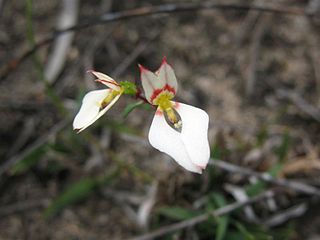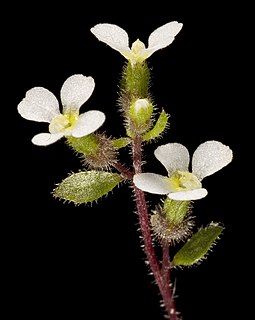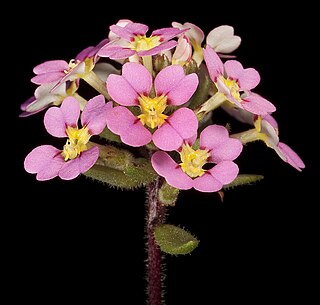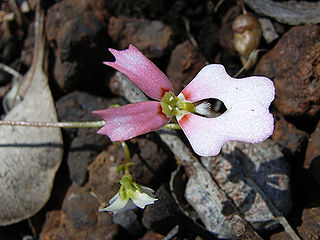
The family Stylidiaceae is a taxon of dicotyledonous flowering plants. It consists of five genera with over 240 species, most of which are endemic to Australia and New Zealand. Members of Stylidiaceae are typically grass-like herbs or small shrubs and can be perennials or annuals. Most species are free standing or self-supporting, though a few can be climbing or scrambling.

Oreostylidium is a genus of flowering plants in the family Stylidiaceae with a single species, Oreostylidium subulatum, that is endemic to New Zealand. O. subulatum is a very small plant with small, white flowers. It has a complicated botanical history that has led to a few proposals to move Oreostylidium to the related genus Stylidium. The researchers cite molecular data and suspect that this species is an extreme example of floral paedomorphosis. This would not be an unprecedented move since the single species was initially described as Stylidium subulatum in 1864 and later moved to its own genus by Sven Berggren in 1878. It possesses the same kind of glandular trichomes underneath the flower that make Stylidium species carnivorous plants, but it has not yet been tested for the presence of digestive enzymes.

Donatia is a genus of two cushion plant species in the family Stylidiaceae. The name commemorates Vitaliano Donati, an Italian botanist.

Gottfried Wilhelm Johannes Mildbraed was a German botanist that specialized in mosses, ferns, and various spermatophytes. He is well known for authoring the most current monograph and taxonomic treatment of the family Stylidiaceae in 1908 as part of the unfinished Das Pflanzenreich series. The genus Mildbraediodendron was named in honor of him.

Levenhookia, also known as the styleworts, is a genus of ten recognized species in the family Stylidiaceae and is endemic to Australia. The genus is restricted to Western Australia almost exclusively with a few exceptions: L. pusilla's range extends into South Australia, L. dubia's range extends through South Australia into Victoria and New South Wales, L. sonderi is native only to Victoria, and L. chippendalei is also found in the Northern Territory.

Levenhookia dubia, the hairy stylewort, is a dicotyledonous plant that belongs to the genus Levenhookia. It is an ephemeral annual that grows from 2–6 centimetres (0.79–2.36 in) tall with obovate leaves that are generally 2–5 millimetres (0.079–0.197 in) long. Flowers are white and bloom from September to October in its native range. L. dubia is most closely related to L. sonderi, which has been described as a variety of L. dubia in the past. It is endemic to Australia and has native ranges in Western Australia, South Australia, New South Wales, and Victoria. Its habitat has been reported as being sandy soils in granite outcrops.

Levenhookia leptantha, the trumpet stylewort, is a dicotyledonous plant that belongs to the genus Levenhookia. It is an ephemeral annual that grows from 2–6 centimetres (0.79–2.36 in) tall with ovate to lanceolate leaves that are generally 2–5 millimetres (0.079–0.197 in) long. Flowers are pink and bloom from September to October in its native range. It is endemic to Western Australia. Its habitat has been reported as being sand or sandy clay soils in granite outcrops and winter-wet depressions.

Levenhookia pauciflora, the deceptive stylewort, is a dicotyledonous plant that belongs to the genus Levenhookia. It is an ephemeral annual that grows from 5–10 centimetres (2.0–3.9 in) tall with ovate to suborbicular leaves. Flowers are white and bloom from September to November in its native range. L. pauciflora is endemic to Western Australia where it grows in sandy soils in sandstone or granitic areas. The flowers of L. pauciflora resemble those of Stylidium ecorne and it has been said that S. ecorne mimics L. pauciflora to take advantage of its pollinators.

Levenhookia preissii, Preiss's stylewort, is a dicotyledonous plant that belongs to the genus Levenhookia. It is an ephemeral annual that grows about 15 centimetres (5.9 in) tall with oblanceolate to linear leaves. Flowers are pink to red and bloom from September to January in its native range. L. preissii is endemic to southwestern Western Australia where it grows in grey or black sandy peat soils in swampy areas.
Levenhookia pusilla, the midget stylewort or tiny stylewort, is a dicotyledonous plant that belongs to the genus Levenhookia. It is an ephemeral annual that grows about 5 to 6 cm tall with suborbicular to ovate-spathulate leaves. Flowers are pink to white and bloom from September to December in its native range. L. pusilla is endemic to southwestern Western Australia and South Australia where it grows in granitic or lateritic soils.
Levenhookia sonderi, the slender stylewort, is a dicotyledonous plant that belongs to the genus Levenhookia. It is an ephemeral annual that grows only in Victoria, Australia. L. sonderi is most closely related to L. dubia and it has even been described as a variety of L. dubia in the past. Johannes Mildbraed was the first person to reduce L. sonderi to a variety of L. dubia in his 1908 taxonomic monograph on the Stylidiaceae in which he noted he could not find any significant difference between L. sonderi and L. dubia to maintain the separate taxonomic treatment of the two species. Later studies have considered the species to be distinct.

Levenhookia stipitata, the common stylewort, is a dicotyledonous plant that belongs to the genus Levenhookia. It is an ephemeral annual that grows about 7–10 centimetres (2.8–3.9 in) tall with oblanceolate to linear leaves. Flowers are pink and bloom from August to January in its native range. L. stipitata is endemic to southwestern Western Australia where it grows in granitic or lateritic soils. This species was first described by George Bentham in 1837 as Stylidium stipitatum and was later reclassified into the genus Coleostylis, which was placed into synonymy with the genus Levenhookia.

Levenhookia sect. Coleostylis is a section of four recognized species in the family Stylidiaceae. It was established and described by Johannes Mildbraed in 1908 to separate the subgeneric taxonomy in the genus Levenhookia. Mildbraed originally placed L. preissii and L. stipitata in this section. L. chippendalei was described in 1966 and placed in this section by Rica Erickson and Jim Willis. Section Coleostylis could also contain L. octomaculata, which Erickson described in 1956, noting its affinities with L. stipitata but without placing it in a section. Otherwise it would be unplaced as to a section.
Levenhookia sect. Estipitatae is a section of two to three recognized species in the family Stylidiaceae. It was established and described by Johannes Mildbraed in 1908 to separate the subgeneric taxonomy in the genus Levenhookia. Mildbraed originally placed L. dubia and L. leptantha in this section. L. sonderi was described by Mildbraed as a variety of L. dubia, though other resources treat it as a distinct species.

Levenhookia sect. Levenhookia is a section of two to three recognized species in the family Stylidiaceae. Section Levenhookia was originally described by Mildbraed as section Eulevenhookia, which was later changed to the current section title Levenhookia as an autonym since it is the type section. Mildbraed originally placed L. pauciflora and L. pusilla in this section. It could also contain L. pulcherrima, which Carlquist described in 1969 and noted its close association to the other two species in section Levenhookia but neglected to place it within a section.

Stylidium calcaratum, the book triggerplant, is a dicotyledonous plant that belongs to the genus Stylidium. It is an ephemeral annual that grows from 5 to 10 cm tall but can grow larger at 20–30 cm tall in damp forest or scrub habitat. The few ovate leaves produced by this plant form basal rosettes around the stem. The leaves are around 3–5 mm long on short petioles. The scapes are 2–30 cm tall and produce single flowers in smaller plants and up to nine flowers in larger, more robust plants. Flowers are pink or white with red spots or lines at the individual petal bases. The petals are vertically paired and will fold over to meet each other at night or in adverse weather conditions. S. calcaratum is endemic to Australia and has a distribution that ranges from Victoria through South Australia and into Western Australia. Its habitat is recorded as being wet flats or near creeks and seepages. Pollination is achieved by a grey fly, Comptosia cuneata.

Stylidium perpusillum, the tiny triggerplant, is a dicotyledonous plant that belongs to the genus Stylidium, that occurs in south west Western Australia.

Forstera bellidifolia, the Tasmanian forstera, is a species in the family Stylidiaceae that is endemic to Tasmania, Australia. It was described by William Jackson Hooker in an 1851 volume of Icones Plantarum. It is notably different from other members of the genus in that it is not native to New Zealand nor does it possess the epigynous nectaries that are present in the other species.

Donatia novae-zelandiae is a species of cushion plant in the family Donatiaceae and is closely related to species in the family Stylidiaceae. It is found in the alpine and subalpine regions of New Zealand and Tasmania. Donatia novae-zelandiae has free stamens and petals, paracytic stomata, and a pollen morphology distinct from the genera of the sister family Stylidiaceae. It was first described by Joseph Dalton Hooker in 1853 and published in his Flora Novae-Zelandiae.

Drosera erythrorhiza, the red ink sundew, is a perennial tuberous species in the carnivorous plant genus Drosera that is endemic to Western Australia. It grows in a rosette and is distinguished from the other species in section Erythrorhiza by its many-flowered cymose inflorescences with up to 50 individual flowers. D. erythrorhiza was first described by John Lindley in his 1839 publication A sketch of the vegetation of the Swan River Colony. In 1992, N. G. Marchant and Allen Lowrie described three new subspecies, thus also creating the autonym D. erythrorhiza subsp. erythrorhiza. The subspecies were separated from this variable species mostly by leaf morphology and distribution.













